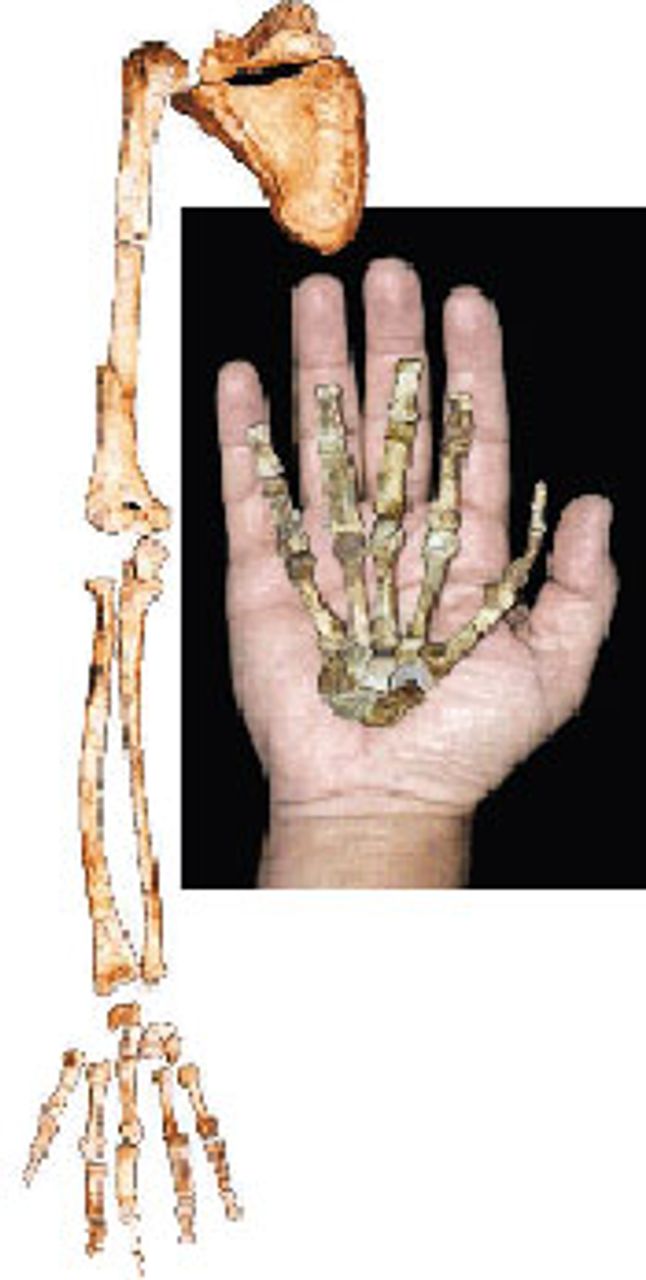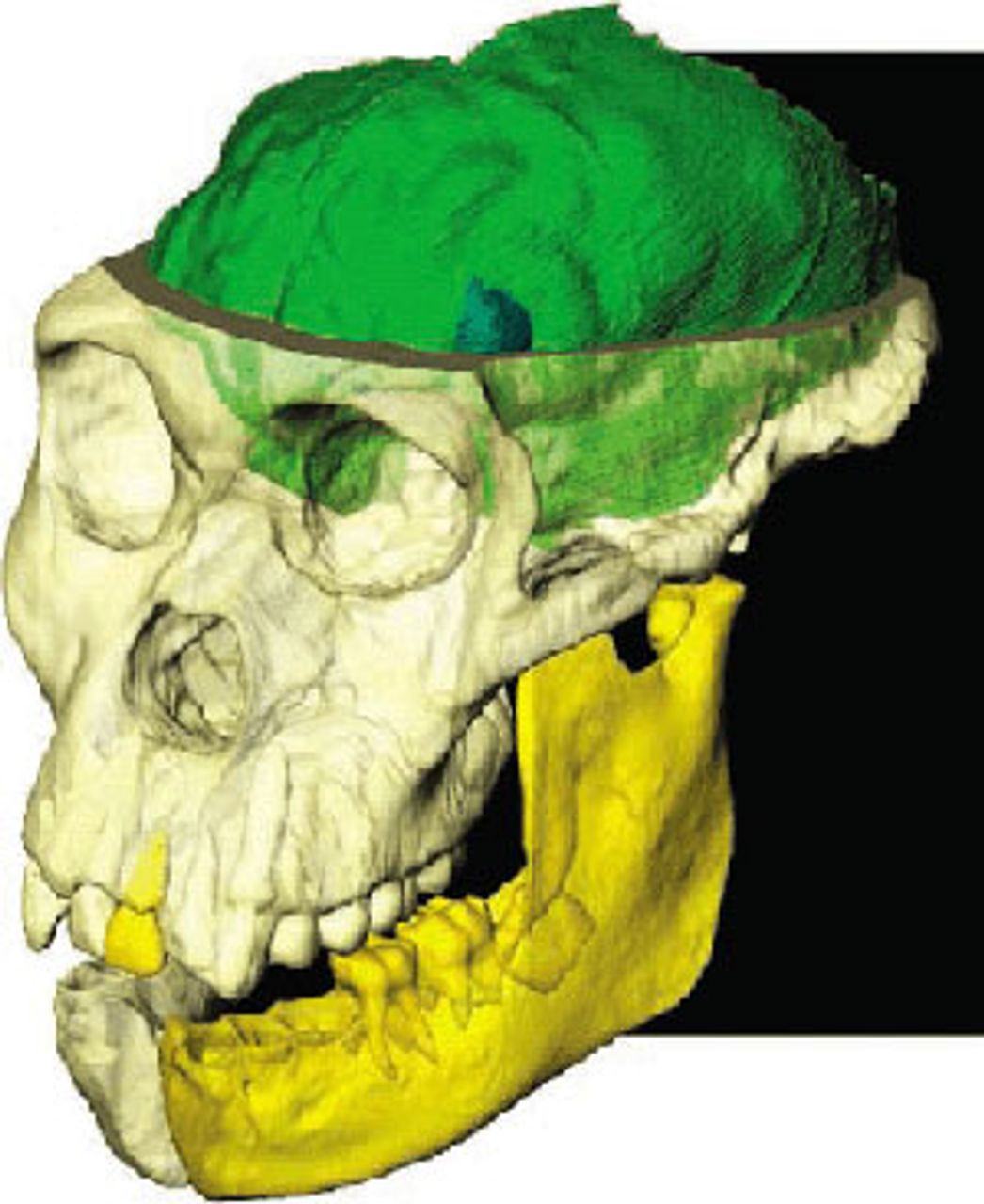A newly reported fossil discovery from the Malapa, South Africa may provide greater insight into the evolution of the genus Homo from our australopithecine ancestors. The fossils consist of remains of two individuals, an adult female and juvenile male, possibly a mother and son. They appear to have fallen into a cave between 1.95 and 1.78 million years ago, perhaps while searching for water, and after death were rapidly covered by sediment. This resulted in a degree of preservation so extraordinary that researchers believe they may have fossilized soft tissues, including skin. Evidence of at least two other well-preserved individuals has also been found.
 Australopithecus sediba hand and arm
Australopithecus sediba hand and armA series of articles in a recent issue of the journal Science describes the first two specimens in detail. The discoverer, paleoanthropologist Lee Berger of University of the Witwatersrand in South Africa, proposes at least provisionally that this new species, which has been named Australopithecus sediba, represents the direct ancestor of the genus Homo, including our own species, Homo sapiens. This controversial proposal would have Au. sediba replace the east African Homo habilis as the direct ancestor of H. erectus, though H. habilis appears in the fossil record approximately 2.4 million years ago, and H. erectus as early as 1.9 million years ago. Whether or not this specific interpretation is correct (a great deal more data would likely be needed to make a convincing case), the sediba individuals possess a variety of traits that illustrate some of the adaptations that became key to later human evolution.
The genus Australopithecus, various species of which existed in Africa from nearly 4.5 to roughly 1.5 million years ago, represents a major event in the evolution of African apes: a shift in one lineage from a primarily forested habitat and ecology to life in a drier and mixed environment of grasslands interspersed with wooded patches. This involved among other things the change from quadrupedal to bipedal (i.e. two-legged, upright) locomotion. It is now widely accepted that the genus Homo evolved from some branch of Australopithecus. However, much of the detail of these evolutionary processes remains to be uncovered through scientific inquiry.
The earliest presently known fossil specimen attributed to the genus Homo (H. habilis) was recovered at Hadar, Ethiopia and dates to roughly 2.4 million years ago. The famous Lucy fossil, assigned to the species Australopithecus afarensis, also from Hadar, dates to 3.2 million years ago. It is during the period between the two that key parts of the transition between Australopithecus and Homo appear to have begun. There are a number of fossil specimens which may represent an intermediate between A. afarensis and H. habilis, most notably Australopithecus garhi, a 2.6 million year old hominin found in Gona, Ethiopia in association with the earliest known stone tools. Nevertheless the direct ancestor of Homo in east or South Africa remains unknown.
The two sediba individuals, portions of which are still being excavated, date to approximately two million years ago and therefore could be argued to be ancestors of H. erectus. They certainly provide insights into what happened during the preceding period, even if they are found too late in the fossil record to be ancestral to Homo. While many researchers once thought that a single lineage likely connected australopithecines to our ancestors in the genus Homo, the discovery of many australopithecine-like specimens in Africa have led scientists to view hominin evolution as characterized by many branching lineages, each possibly specific to a given place and time.
Numerous species of Australopithecus have been identified in eastern and southern Africa, variously named Australopithecus africanus (a possible ancestor of sediba), A. garhi, and the somewhat older A. bahrelgazali and Kenyanthropus platyops. There were also many species of the genus Paranthropus living in sub-Saharan Africa during this period, all characterized by small brains, powerful jaw muscles and huge teeth, a condition known as “megadontia.” Some of these persisted for up to a million years after the appearance of the first members of Homo. The earliest known stone tools, classified as the Oldowan Industry, are generally attributed to Homo habilis, in East Africa, though A. garhi has been found near stone tools dated to 2.6 million years ago. It is likely that australopithecines did use tools to some degree. The development of the ability to make and use stone tools on a substantial scale appears to have been closely associated with the appearance of the genus that eventually gave rise to modern humans.
 Australopithecus sediba skull with virtual endocast
Australopithecus sediba skull with virtual endocastThe two Au. sediba specimens so far examined exhibit a mixture of traits: a “mosaic” of relatively advanced and primitive features in the skull, the hand, the pelvis, and the foot. In a sense, these individuals may be considered examples of “evolution in action.” They appear to reveal a species in the process of adapting to a new environmental setting (i.e., open savannah), probably in part by cultural means, but retaining the ability to function to some degree in the old environment (i.e., a more forested setting). Of particular interest are developments in the brain and the hand.
The interior of the young male’s skull has been precisely recorded using a sophisticated form of CAT scanner widely used in the fields of medicine and engineering. X-ray computed tomography assembles large series of x-rays in order to reconstruct three-dimensional, “virtual” copies of tissues or objects with complex internal morphology. The sediba skull was scanned at a special facility operated by French scientist Paul Tafforeau in Grenoble. Tafforeau has made highly precise and powerful “synchrotron” x-ray beams widely available to paleontologists from around the world, greatly enhancing the ability of scientists to look not only at, but also into fossils.
This technology has yielded the most detailed image yet created of an early hominin brain (such an image is called an “endocast”). Although the boy’s brain was barely larger than that of a chimpanzee, the researchers propose that there are distinct changes in architecture resembling developments in later humans. Of special importance are enlargements in frontal areas of the brain known to be associated with social behavior, language, and probably tool-making. Preliminary studies appear to indicate that these changes distinguish this brain from those of other known australopithecine specimens and indicate that while the brain is smaller than that of H. habilis, in sediba it has been reorganized.
This finding if confirmed could suggest that sediba’s brain was small, but more humanlike than that of habilis. Alternately, it could also suggest that both habilis and sediba possessed re-organized brains, either having evolved independently or having been acquired from a common ancestor. The idea that the ancestral human brain was first reorganized before growing in size was largely popularized by scientist Ralph Holloway of Columbia and New York’s American Museum of Natural History. Endocasts were recently used by scientist Dean Falk to argue that the “hobbit” from Flores, with its unusually small brain, was probably not afflicted by a disorder called microcephaly.
A nearly complete specimen of the right hand and wrist from the adult female includes a relatively lengthened thumb while the other fingers are shorter, a trend begun in earlier australopithecines such as Lucy, along with other, more advanced characteristics, according to the analysis presented by the discoverer. This reduced difference in length between the digits would have enhanced the ability to oppose the thumb to the other fingers facilitating the “precision grip” that is characteristic of humans and necessary for the production of sophisticated tools and other manipulative activities. At the same time, the hand retains a relatively flexed configuration useful in tree climbing, characteristic of other australopithecines and of apes, but not of Homo.
The conjunction of developments in cognitive capabilities and in the hand seen in Au. sediba raise the possibility that the ability to modify objects as observed in the genus Homo may not have required, at first, a large brain. Further analyses will be needed to elucidate the relationship between sediba’s brain, hands and any discovered stone tools. Frederick Engels contended 135 years ago in his work The Part Played by Labor in the Transition from Ape to Man that the coordinated development of mental and manual facility were key to early human evolution, a minority view at that time, though now widely accepted by most scientists and many archaeologists. Again, however, further analysis is needed to confirm the assessment of these particular fossils.
The fossils also reveal pelvises and feet that again combine attributes characteristic of Australopithecus and of Homo and some possibly unique to this species. Of particular note, the pelvises do not show an enlargement of the birth canal. This is consistent with the small size of the recovered skull and indicates that possible brain reorganization, but not enlargement was taking place in this lineage. In other words, the “obstetrical dilemma” was not a problem for Au. sediba. It should be noted that H. habilis did have a relatively enlarged brain size, but its internal architecture is not known in detail.
Interestingly, the foot morphology appears to have certain characteristics appear to suggest that Au. sediba walked in a way that was distinct from the mode characteristic of Homo, possibly supporting the interpretation that this species was not the direct ancestor of the latter genus. Most interestingly, sediba’s foot retains substantial adaptations for climbing, and possesses a small heel very unlike modern humans, our Homo erectus ancestors and even more primitive australopithecines. Nevertheless some aspects of the sediba ankle appear human-like, probably an adaptation to habitual walking.
The analysis and interpretation of these fossils are still at an early stage. As with all such discoveries, the dialectical process of scientific research involves the proposal of certain interpretations by one group of researchers and the criticism and testing of these proposals by others. Berger’s suggestion that Australopithecus sediba is the direct ancestor of the genus Homo contradicts the existing interpretation, which places the older east African Au. afarensis (i.e. Lucy) or other lineages at that position. There are prominent researchers in the field, including Donald Johanson, the discoverer of the Lucy fossil, who say that Berger is exaggerating the significance of his discovery. The struggle for recognition and funding sometimes leads to grandstanding, which is not a new phenomenon in science, as for example in the recent media frenzy over the early primate fossil “Ida.”
Speaking to the New York Times, paleoanthropologist Bernard Wood has cast doubt upon the notion that sediba is an ancestor of Homo erectus. Wood argued that Berger’s commitment to timely publication and his efforts to make the sediba material accessible have all been commendable. The discovery of Australopithecus sediba is undoubtedly a monumental event in the study of human origins.
It must be remembered that, even with these new discoveries, the sample size of early hominin fossils remains small. The range of variation within and between species is not well understood and will require further research. It may well be that there were multiple species of australopithecines that “experimented” with various ways of living that relied on increasing intelligence and the use of tools. Ultimately, it appears that only one group was successful in this endeavor, giving rise to the genus Homo.
